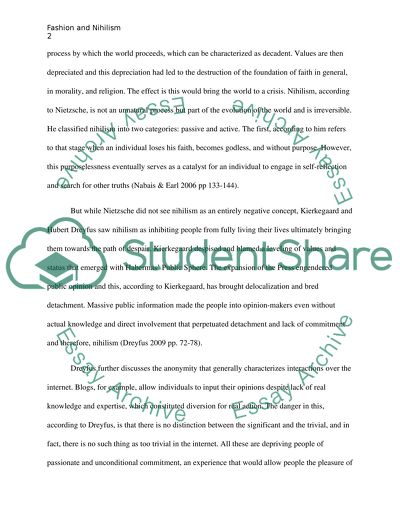Cite this document
(Fashion and Nihilism Essay Example | Topics and Well Written Essays - 1750 words, n.d.)
Fashion and Nihilism Essay Example | Topics and Well Written Essays - 1750 words. https://studentshare.org/sociology/1573159-as-covered-on-the-huffington-post-does-the-world-of-fashion-exhibit-nihilism-as-nietzsche-and-dreyfus-define-the-term-why-or-why-not-should-pcc-students-be-concerned-with-any-nihilism-in-the-fashion-world
Fashion and Nihilism Essay Example | Topics and Well Written Essays - 1750 words. https://studentshare.org/sociology/1573159-as-covered-on-the-huffington-post-does-the-world-of-fashion-exhibit-nihilism-as-nietzsche-and-dreyfus-define-the-term-why-or-why-not-should-pcc-students-be-concerned-with-any-nihilism-in-the-fashion-world
(Fashion and Nihilism Essay Example | Topics and Well Written Essays - 1750 Words)
Fashion and Nihilism Essay Example | Topics and Well Written Essays - 1750 Words. https://studentshare.org/sociology/1573159-as-covered-on-the-huffington-post-does-the-world-of-fashion-exhibit-nihilism-as-nietzsche-and-dreyfus-define-the-term-why-or-why-not-should-pcc-students-be-concerned-with-any-nihilism-in-the-fashion-world.
Fashion and Nihilism Essay Example | Topics and Well Written Essays - 1750 Words. https://studentshare.org/sociology/1573159-as-covered-on-the-huffington-post-does-the-world-of-fashion-exhibit-nihilism-as-nietzsche-and-dreyfus-define-the-term-why-or-why-not-should-pcc-students-be-concerned-with-any-nihilism-in-the-fashion-world.
“Fashion and Nihilism Essay Example | Topics and Well Written Essays - 1750 Words”. https://studentshare.org/sociology/1573159-as-covered-on-the-huffington-post-does-the-world-of-fashion-exhibit-nihilism-as-nietzsche-and-dreyfus-define-the-term-why-or-why-not-should-pcc-students-be-concerned-with-any-nihilism-in-the-fashion-world.


